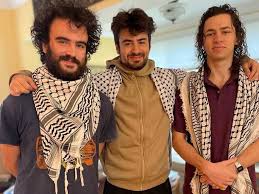
Introduction
The kuffiyeh, also known by various names such as the keffiyeh or ghutrah, is more than just a traditional Middle Eastern headdress; it embodies a rich cultural history and a significant political narrative. Primarily worn by Arab men, this distinctive garment has evolved over the years to represent cultural identity, solidarity, and resistance. From its practical origins in the arid landscapes of the Middle East to its current status as a global symbol of activism, the kuffiyeh’s journey is a fascinating exploration of tradition, politics, and fashion.
Historical Background
The kuffiyeh’s origins can be traced back to ancient civilizations in the Middle East, where the harsh desert climate necessitated protective clothing. Initially, this headscarf served functional purposes: it provided shade from the sun, protection against dust and sandstorms, and warmth during cold desert nights. Made from natural materials such as cotton, wool, or linen, the kuffiyeh was both practical and versatile.
The name “kuffiyeh” is derived from the Arabic word for the city of Kufah in Iraq, which is thought to be one of the early centers of its use. Over centuries, different regions developed their unique styles and methods of wearing the kuffiyeh, influenced by local customs, climate, and available materials. In rural communities, variations often indicated social status, regional affiliation, or tribal identity.
Styles and Variations
The kuffiyeh comes in various colors, patterns, and styles, each with distinct meanings and uses. Among the most recognizable is the black-and-white checked kuffiyeh, often linked with Palestinian identity. This particular style has become emblematic of Palestinian nationalism, especially during the late 20th century when it was popularized by political leaders and activists.

- Ghutrah: Typically a plain white or red-checkered scarf, the ghutrah is more common in the Gulf States and is often worn with a headband known as the agal. The white version is frequently worn in the summer, providing relief from the sun, while the red-checkered variety is preferred in cooler months.
- Shemagh: A thicker variant of the kuffiyeh, the shemagh is commonly worn in Jordan and other areas of the Levant. Its fabric is typically more robust, making it ideal for protection against the elements.
- Variations by Region: In addition to the aforementioned styles, various regions have developed their own patterns and ways of draping the kuffiyeh. For instance, in some Bedouin communities, brightly colored kuffiyehs are worn as a symbol of tribal pride.
Cultural Significance
The cultural significance of the kuffiyeh cannot be overstated. It has evolved from a simple piece of headgear into a powerful symbol of Arab identity and heritage. Throughout history, it has been associated with various cultural practices, rituals, and social norms.
In the context of Palestinian nationalism, the kuffiyeh gained prominence during the First Intifada in the late 1980s when it became a symbol of resistance against Israeli occupation. Activists wore it to express solidarity and to promote their struggle for rights and recognition. The image of the kuffiyeh-clad protester became iconic, cementing its status as a symbol of the Palestinian cause.
Furthermore, the kuffiyeh has found a place in broader discussions about identity, representation, and social justice. For many, it represents resilience against oppression and a commitment to cultural heritage. It has been adopted by various movements worldwide, symbolizing solidarity with marginalized communities, transcending geographical and cultural boundaries.
Modern Interpretations and Global Impact
In recent years, the kuffiyeh has gained international popularity, becoming a fashion statement that transcends its traditional roots. Designers in the fashion industry have embraced the kuffiyeh, incorporating its patterns and styles into their collections. It has appeared on runways, in music videos, and as a prominent accessory in streetwear, often devoid of its original political context.
While this globalization of the kuffiyeh has allowed for a wider appreciation of its aesthetic qualities, it has also sparked discussions about cultural appropriation and sensitivity. Critics argue that the commercialization of the kuffiyeh risks diluting its cultural significance and reduces it to mere fashion. Advocates, on the other hand, emphasize the importance of understanding and respecting the kuffiyeh’s historical and political context. They argue that awareness and education about its significance can foster appreciation rather than appropriation.
In social media, the kuffiyeh has found new life as a symbol of activism. Many activists and influencers use the kuffiyeh to express solidarity with various causes, from Palestinian rights to broader issues of social justice and equality. It serves as a visual statement that connects people across borders and cultures, highlighting shared struggles against oppression.
How to Wear a Kuffiyeh
Wearing a kuffiyeh is an art form, and there are several traditional methods to don it, depending on personal preference and style. Here’s a detailed guide on how to wear a kuffiyeh:
- Choosing the Right Fabric: Select a kuffiyeh made from breathable materials like cotton for warmer climates, or a thicker version for cooler temperatures.
- Folding the Kuffiyeh: Start by laying the kuffiyeh flat on a surface. Fold it diagonally to form a triangle.
- Positioning the Kuffiyeh: Place the folded edge across your forehead, ensuring the longer sides hang down on either side.
- Draping the Ends: Bring the two ends of the kuffiyeh around to the back of your neck. Depending on the style you want, you can either tie them together or allow them to drape down freely.
- Adjusting for Fit: Adjust the fit around your forehead and neck for comfort. Some prefer a loose fit for a casual look, while others may prefer a tighter style for a more polished appearance.
- Styling Variations: Depending on the occasion, you can experiment with different draping styles. For instance, during formal events, you might opt for a more structured look, while for casual outings, a relaxed drape works well.
Kuffiyeh in Art and Literature
The kuffiyeh has also found its way into art and literature, serving as a powerful symbol in various forms of expression. Artists and writers have used the kuffiyeh to convey themes of resistance, identity, and cultural pride.
Visual artists often depict the kuffiyeh in their works to represent the struggles of the Palestinian people and to highlight broader themes of oppression and resilience. It has become a motif in paintings, murals, and photography, often portrayed alongside imagery of protest or cultural celebration.
In literature, the kuffiyeh appears as a symbol of heritage and identity in poems and narratives that explore the complexities of Arab identity, migration, and cultural memory. Authors use the kuffiyeh to evoke a sense of place and belonging, connecting characters to their roots while navigating the challenges of modern life.
The Kuffiyeh and Environmental Sustainability
Interestingly, the kuffiyeh has also garnered attention in discussions around environmental sustainability. As awareness grows regarding the impact of fast fashion on the environment, there is a renewed interest in traditional garments like the kuffiyeh that are often made from natural, sustainable materials.
Crafted by local artisans, many kuffiyehs are produced using traditional methods that have a minimal ecological footprint. This emphasis on craftsmanship aligns with the global movement towards sustainable fashion, promoting the idea that clothing can be both culturally significant and environmentally responsible.
Conclusion
The kuffiyeh is a multifaceted symbol that embodies a rich tapestry of cultural, historical, and political narratives. From its practical origins as a protective garment to its status as an emblem of resistance and identity, the kuffiyeh continues to inspire and connect people across the globe.
As it navigates the complexities of modernity, globalization, and cultural appropriation, the kuffiyeh remains a potent reminder of the power of clothing as a form of expression. It invites us to reflect on our own identities and the histories that shape them, urging us to appreciate the stories woven into the fabric of our lives. Whether worn in the deserts of the Middle East or adopted as a fashion statement in urban centers, the kuffiyeh stands as a testament to resilience, pride, and the enduring significance of cultural heritage.For more detail please visit techwebinsights.com
4o mini







